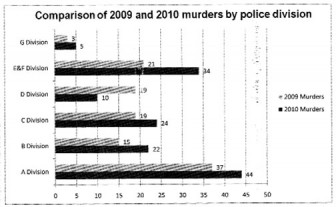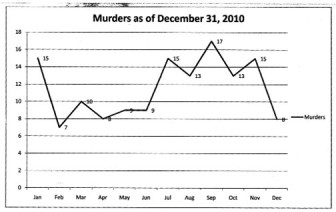Mysterious hit-men with high powered rifles, gun-slinging robbers and blade wielding attackers left a trail of bodies throughout 2010 taking the murder count to 139 by year end. More than half of these cases remain on the “to be solved” list of the Guyana Police Force (GPF).
As at December 31, 2010 Stabroek News recorded a total of 139 murders countrywide for that year. The same number has been recorded by the GPF and indicates a 21.9% increase in killings from 2009. There were 114 murders in 2009.
Last year there was one murder every 62h 24m (2.6 days) and in 2009 there was one every 77h 48m (3.2 days). Further, during that year, 111 of the murder victims were male and shooting was the leading method used by perpetrators to kill. In December all victims were male.
September was the month with the highest murder count of 17 in 2010, while the lowest, 7, was recorded in February. The year started off with a high (10 and over) of 15 murders in January and then slowed down from February and June. In July, the murder rate went up to 15 again and maintained a high until November. The last month of 2010 recorded a low of 8 murders.


Guns were responsible for 34% (more than a third) of the murders in 2010. There have been 32 stabbings, 11 cases of chopping, 20 cases of wounding by another method, 10 cases of battering, four victims drowned, three were electrocuted, five burnt, four strangled, one was suffocated, and five died in other circumstances.
Meanwhile, five of the six police divisions recorded an increase in murders last year. The only area with a decrease in killings last year was police ‘D’ Division (West Demerara/ East Bank Essequibo).
Commander of ‘D’ Division, Assistant Commissioner Balram Persaud told Stabroek News last week that he believed the lower murder count in his division was as a result of thorough policing. Most of the 10 murders last year (9 less than 2009) were due to disorderly behaviour, he explained.
Despite this ‘D’ Division is still answerable for a string of events which led to the murder of teenager Neesa Gopaul. Gopaul’s body was discovered in a creek at abandoned resort Emerald Tower, Soesdyke/Linden Highway (A Division) in early October. Her murder sparked a series of investigations in two government ministries (Education and Human Services), generated much public interest and many demands for answers about how and why the system failed Gopaul.
In February 2010, HIV counsellor Seeraj Persaud was discovered dead in his office at the Parika Health Centre, East Bank Essequibo. A post-mortem examination revealed that the man died from strangulation but investigators have been unable to find Persaud’s murderer who would have walked into his office during daylight hours, strangled him and exited the scene.
There were increases of 7 murders each in the police ‘A’ Division (Conversation Tree to Dora, Soesdyke/Linden Highway) and ‘B’ Division (Berbice). In 2009, 15 murders were recorded in Berbice and last year this number increased to 22. Last year there was a murder count of 44 in ‘A’ Division. This police division continues to have the highest numbers of killings.
Executions
Most of the murders in ‘A’ Division have occurred in Georgetown. On January 8 and 12 last year Vibert Weekes and Nicholas Hoyte were riddled with bullets at separate city locations.
The next execution-style killing occurred in Albouystown in April. Ryan Brimmer was shot to death while fetching scrap metal with his cousins. This case remains unsolved. In mid June, 2010 Jamal ‘Radio’ Beete, brother of former wanted man Tyron ‘Cobra’ Rowe, was discovered dead in an unoccupied George Street house. Beete was shot execution style and the house has since been torn down leaving police with a partially processed crime scene which no longer exists.
On October 1, 2010 Mark Caesar was riddled with bullets while standing at a street corner in Charlestown. Three days later, on Stone Avenue in the city, Patrick Goodluck and Godfrey Grootfaam were riddled with bullets as they were leaving the area in a car.
These cases are only a fraction of the murders tallied in Georgetown during 2010.
Last year the murder count in police ‘C’ Division (begins at Conversation Tree and continues along the East Coast Demerara) increased by 5 from 2009. Mon Repos businessman Rajendra Motilall Sonilall was executed in April and then in Cummings Lodge, just outside the ‘A’ Division border, five persons including a child killed in a spray of bullets from high-powered weapons in September 2010. Both these executions remain unsolved.
E&F Division
The highest increase in murders last year was recorded in police ‘E&F’ Division (interior locations). There were 13 more murders in this division last year than in 2009. ‘E&F’ Division also had the second highest number of murders recorded in any police division. There was a total of 34 murders, 10 less than ‘A’ Division, in this division.
Earlier this year, when questioned about the murder rate ‘E&F’ Division Commander Assistant Commissioner David Ramnarine had told this newspaper that it was extremely difficult to fight crime in his division.
He attributed this difficulty to a number of factors including lack of resources, the size and topography of the division and a shortage of staff.
The double murder of gold dealers Ramdeo Deonarine and Jainarine Raghubir at Bartica in September and then the discovery of the bodies of wanted men Kurt ‘Glasses’ Thierens and Adriano Tracey were the cases from ‘E&F’ Division which generated a lot of public interest.
Thierens and Adriano were found in shallow graves at First Savannah, Kara Kara Creek and were allegedly a part of a gang which had set up a training camp there. This case, perhaps more than any other, exposed the sort of chillingly dangerous criminal activities which can be conducted in a division with this size and geographic characteristics, without the knowledge of the police.









